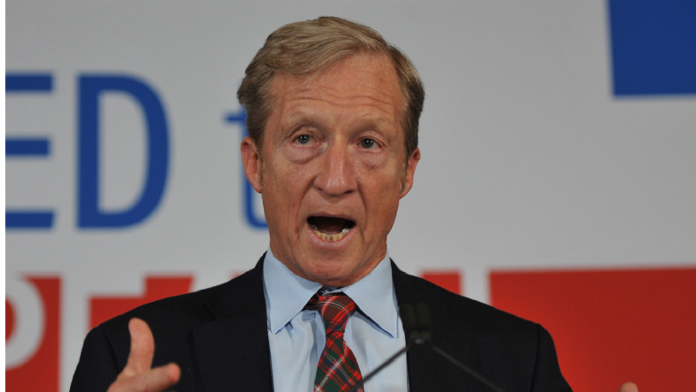Democratic Presidential Candidate Tom Steyer has made climate change his top priority as he runs for office, but while the billionaire rallies against fossil fuels on the campaign trail and claims to be divested from fossil fuels, a New York Times review of his financial disclosures shows that’s not the case.
After qualifying for the most recent Democratic debate, the Times notes that Steyer said on stage, “Over 10 years ago I realized that there was something going on that had to do with fossil fuels, that we had to change. So I divested from fossil fuels.”
But a fact check by the Times rates that statement as “exaggerated,” pointing out the difficulties in fully divesting from the fossil fuel sector. According to the report, Steyer holds a small investment of approximately $4,500 in the Colorado-based oil field services company Direct Petroleum Exploration Inc. which lists onshore assets in Russia, Morocco and Bulgaria.
He also has between $1.25 million and $5.5 million invested in funds managed by an Australian firm “that is the second largest shareholder of the oil and gas exploration company Strike Energy Limited.”
Steyer invested between $5 million and $25 million in a fund that owns shares of Summit Midstream Partners, which develops, owns and operates energy infrastructure. Steyer also has millions of dollars invested in funds that Times says are difficult to determine whether or not they include oil and gas related stocks.
Steyer’s emphasis on climate issues and ending fossil fuel production and consumption is in stark contrast to his past career where he made billions in part by investing in and facilitating large scale coal projects. A separate investigation by the Times showed that money lent by Farallon Capital, the hedge fund Steyer founded, helped develop mining and coal projects that are expected to produce tens of millions of tons of carbon dioxide annually for the next few decades. Over the past 15 years, even in years since Steyer left the fund, Farallon Capital invested hundreds of millions of dollars in coal mines and coal-fired power plants in China and Indonesia.
After leaving his hedge fund Farallon Capital in 2012, Steyer decided to dedicate time and funds to environmental causes, with the Washington Post characterizing him as “giving the left its own billionaire donor to counter the powerful Koch brothers on the right.” Since then Steyer is estimated to have spent over $163 million on climate change issues and candidates between the 2014 and 2016 elections alone mostly through his political action committee (PAC) NextGen Climate.
Steyer and his groups have pumped millions of dollars into political races throughout the West with an eye on electing officials interested in implementing climate change-minded policies.
According to the Wall Street Journal, Steyer’s PAC spent $8.5 million to defend U.S. Senator Mark Udall (D-Colo.) in his 2014 race, which he ultimately lost to Cory Gardner (R).
As Western Wire reported, Steyer was involved in five Colorado House and Senate races in competitive districts in 2018. The Steyer-backed League of Conservation Voters (LCV) have poured millions of dollars in western races, targeting members of the Congressional Western Caucus. He donated $70,000 to five Nevada legislative candidates in the 2018 midterm election cycle, including $10,000 to the sponsor of a bill that would have banned fracking in the state. He also spent $7.5 million that same year on getting out the vote in eight states, including Nevada.
Steyer has also personally supported a fracking ban in California and implored state delegates to pursue the policy.
As a part of his 2020 platform, Steyer says, “On day one of my presidency, I will declare the climate crisis a national emergency.” He also aims to “Eliminate fossil fuel, asthma-causing and toxic air pollution from all sectors” and double down on achieving a 100 percent clean electricity by 2040. Steyer has also pledged to stop issuing leases for fossil fuel production on public lands and will “end federal permitting for new fossil fuel infrastructure on day one of my administration.”

